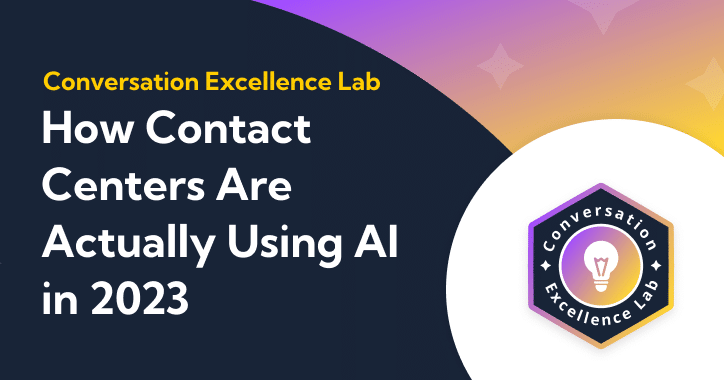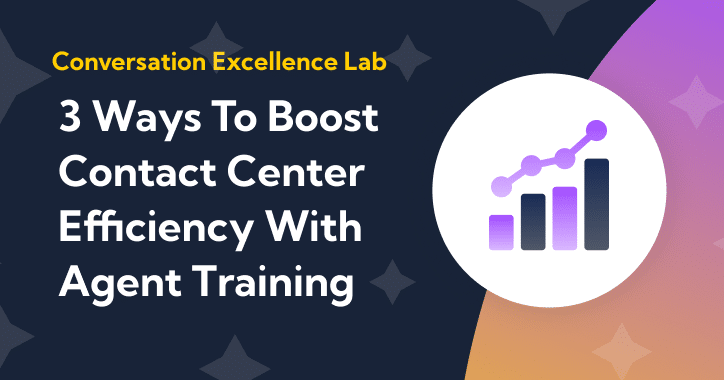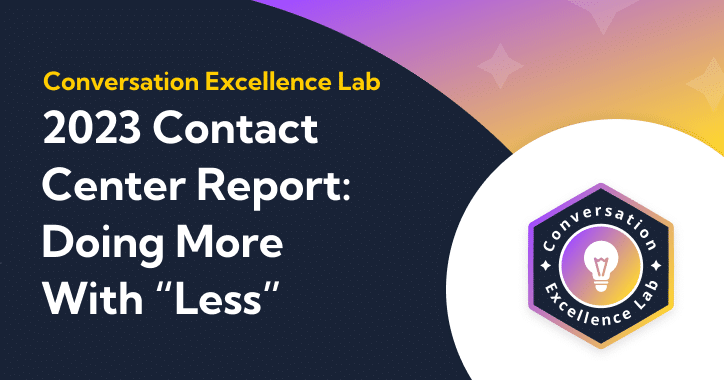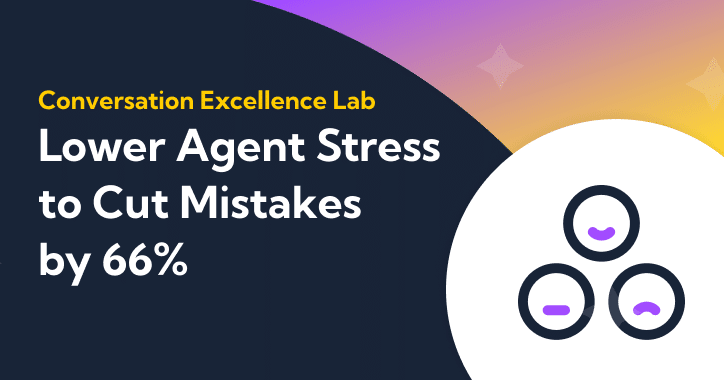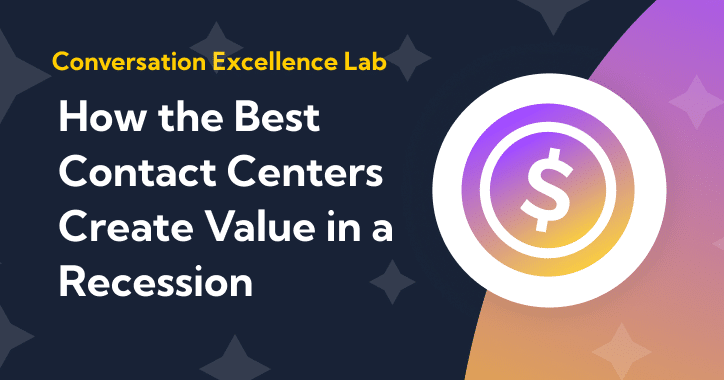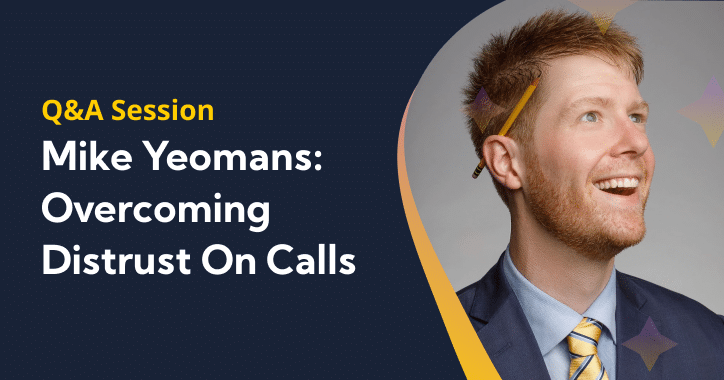Key Takeaways
- There are various tangible benefits to an age-diverse workforce, including lower overall turnover for older employees, differentiated thinking across the organization, and opportunities for mentorship in both directions.
- Generational differences in motivation at work are less pronounced than differences that come along with a person’s life stage.
- The percentage of salaried workers (vs. hourly) increases with tenure. Salaried workers have higher overall job satisfaction.
- Pay is the primary motivator for all age groups, but the longer someone has been at a job, the less likely they are to be motivated to stay at a job by pay.
- The percentage of people who said that they were perfectly happy with their job and didn’t want to leave increased with age.
These findings are part of our series on agent attrition in today’s contact centers. Check out our full report here.
Subscribe to future Conversation Excellence Lab reports below:
It should come as no surprise that those just entering the workforce have a different set of motivations than those who have been in it for decades. We surveyed over 2000 contact center workers of all ages and backgrounds in order to understand what motivates them: What would make them stay at a job? What would make them leave?
The answers we received varied depending on a number of factors, including age. We received differing responses from all age cohorts, from Generation Z to Baby Boomers:

Figure 1: Age Breakdown of Attrition Survey Respondents
Generational differences must be taken with a grain of salt. Various studies, especially those around the workforce, have yielded little to no evidence of major workforce attitude differences between generations.
Our assumption is that variances are driven not by generational differences but by the intersection of age and life stage. These variances are worth exploring to help better understand how to create a workforce suitable for all ages, including benefits and a work environment that ensures everyone is getting what they need to be happy and successful at work, regardless of age.
Current State of Affairs
Pay
We found that wage and salary levels were directly correlated with tenure. Those who had been in the contact center industry for 5+ years made about $4 an hour more on average than those who had been in the contact center industry for < 1 year. Salary was less correlated with tenure than hourly wage and tended to stagnate between 1-5 years before going up again slightly.
It seems that hourly employees’ wages go up consistently over their career, while salaried contact center employees’ pay rises but then stays mostly stable after the beginning of their careers.
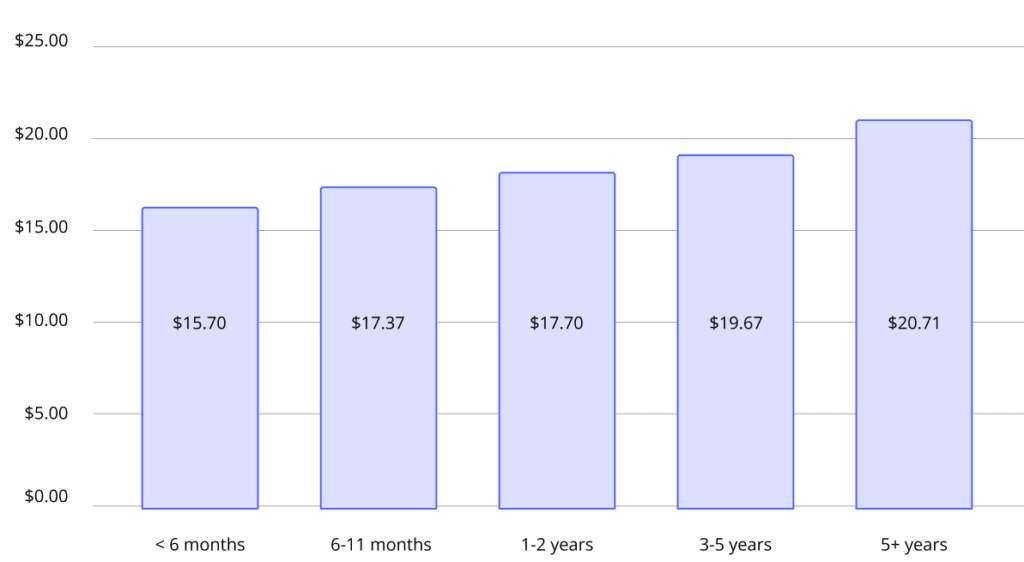
Figure 2: Hourly Wage by Tenure
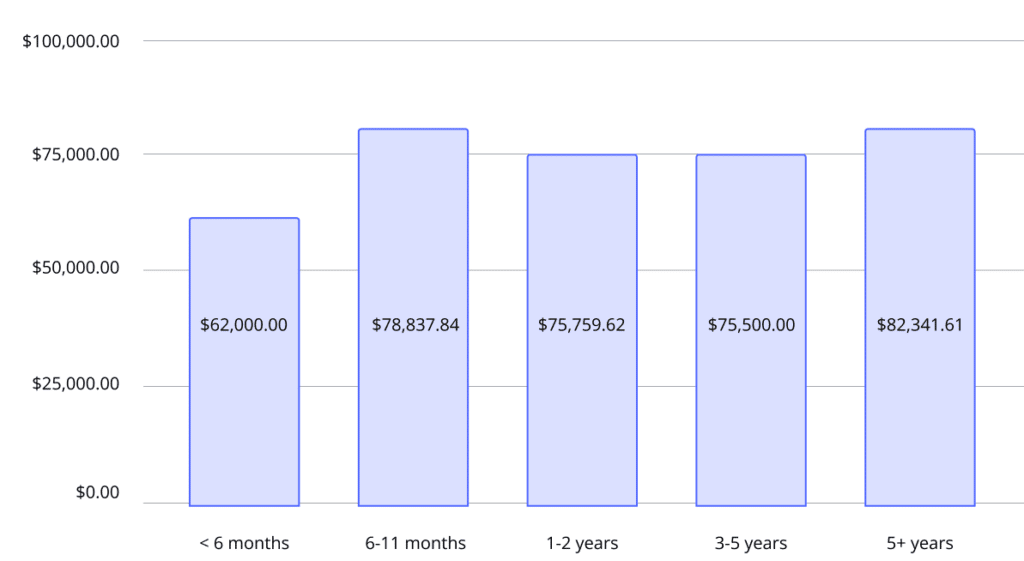
Figure 3: Salary by Tenure
Tenure and age were directly related to whether an employee was paid hourly or had a salary. Those who had been in their position for 5+ years were 3x as likely to be salaried as those who had been in their role for < 6 months.
Job Enjoyment
Salaried employees overall had higher levels of job enjoyment than hourly employees.
In general, job enjoyment was lowest when employees were at their job for <2 years, increased significantly in the 3-5 year range, then dropped slightly when they had been at their job 5+ years. This suggests that employees see the most job enjoyment in the early to mid-stage of their career, where they may be learning and advancing at the fastest rate.
Advancement Opportunities
Satisfaction with advancement opportunities was highest for those 3-5 years into their job. The least satisfied by tenure were those who had been in their job for 1-2 years, followed by those who had been in their job for < 1 year. It appears it takes a year or so to fully comprehend one’s advancement opportunities; afterward, satisfaction with advancement is high. This satisfaction wanes at the five-year mark as people either become more comfortable in their current position or lose a degree of optimism.
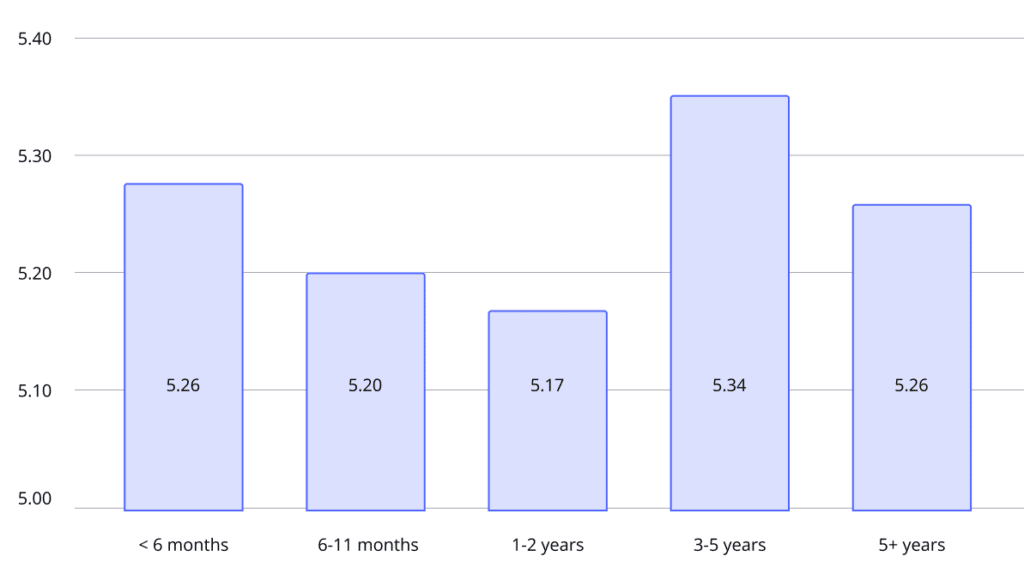
Figure 4: Satisfaction with Advancement Opportunities by Tenure
Industry & Automation
We found that the oldest employees worked in Travel & Hospitality and Manufacturing, while the youngest worked in Retail and Financial Services. Consistent with our findings regarding motivation outlined below, both Travel & Hospitality and Manufacturing ranked highly among those who want to make friends at work.
Those in Financial Services were some of the most worried about their job being automated. This aligns with our findings that those in the 18-34 age bracket were the most worried about automation in general. From age 35 and onward, there was a steady decline in fear of automation.
Older cohorts may be less afraid of automation for a few reasons:
- They do not see themselves staying in the workforce for long enough to see its consequences on their livelihood.
- They are less likely to keep up to date with technological trends that make such automation possible.
- They are familiar with the idea of automation, but no longer take it seriously as a threat to their employment (something akin to alarm fatigue).
The third theory is consistent with the fact that respondents in the Telecommunications & IT industry tended to be most afraid of automation, and younger than average overall.
What Do Employees Want?
Motivation to Stay
We asked our respondents what, if anything, would make them stay in their current job. Pay was the primary motivator for all age groups, but particularly for respondents under the age of 35.
Those over the age of 55 were the least motivated by pay. In general, the longer someone was at a job, the less likely they were to be motivated by pay. The longer their tenure, the more likely it was that they would be motivated by the prospect of a promotion and advancement rather than the number on their paycheck.
We asked respondents what made them join the contact center industry to begin with, and answers here also varied by age.
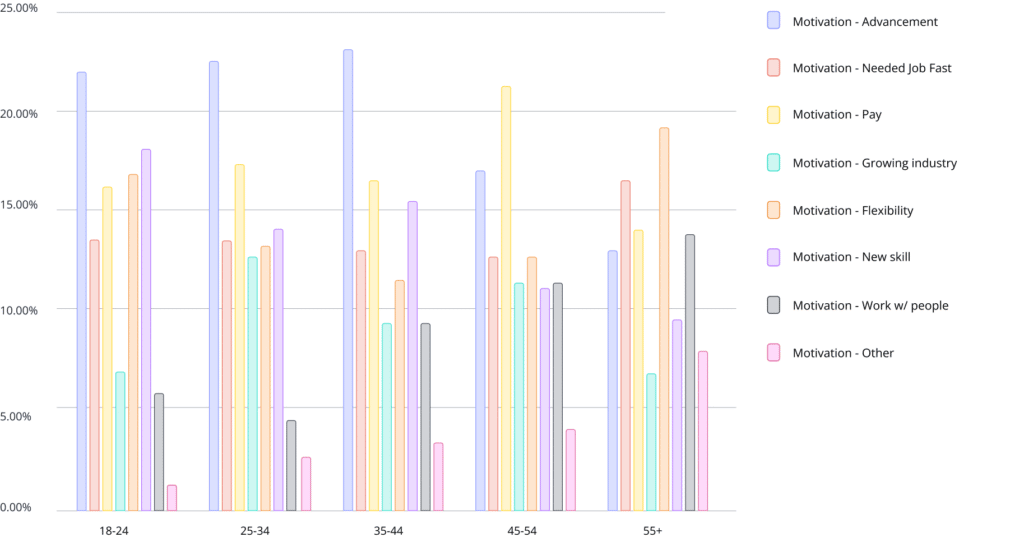
Figure 5: Motivation to Stay in Current Role by Age Group
Answers also varied based on whether the employee was a front-line contact center worker or part of team leadership. Front line workers across all age groups were most likely to join the contact center industry because of pay and commission as well as opportunities for career advancement, and least likely to join because of the chance to work with people or join a growing industry. Those in leadership positions were most likely to join the contact center industry for career advancement and least likely to join in order to work with people and make friends at work.
It seems that as people progress in their careers, they are less and less motivated by opportunities for advancement. Those in the 45-54 age group presumably have more dependents and other life factors that lead them to value their pay above all. In the 55+ range, motivation switches to having a flexible work schedule, as people may start to think about retirement and want to work a bit less.
Interestingly, those under 44 cared least about working with people or making friends at work. It cannot be assumed, however, that younger employees do not value belongingness, but rather that they might not expect it from their workplace. With dozens of digital channels to make connections, less pressure may be placed on the workplace to provide these meaningful connections.
Motivation to Leave
We asked participants what would make them leave their contact center job. The percentage of people who said that they were perfectly happy and didn’t want to leave increased with age. In fact, the percentage of those who said they didn’t want to leave was more than 4x higher for the 55+ cohort than it was for those aged 18-24.
Pay was the primary motivator for leaving for every age group, but it was lowest for those 55+ years old. Even though those aged 35-44 reported being most satisfied with pay. The oldest cohort is not the most satisfied with pay but at the same time, is the least motivated by pay as a whole. This discrepancy could be because they value things like job stability and security more highly, or are more motivated to leave their job by prospects like retirement.
5-Year Outlook
Finally, we asked respondents where they saw themselves in 5 years. The answers varied widely by age and painted a clear picture of motivation and outlook at each distinct life stage.
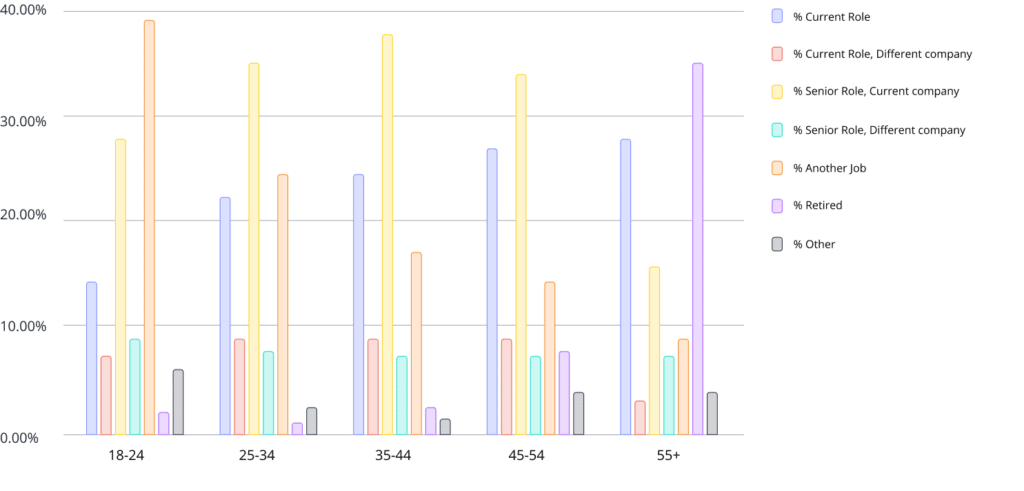
Figure 6: Motivation to Leave Current Role by Age Group
At the beginning of someone’s career, they are most likely to want to try out different jobs in different industries. Once they have been in the workforce for a couple of years, they are more interested in growth and advancement at their current company and are less likely to want to start over. At the 55+ threshold, employees start looking forward to retirement and want least of all to start over or switch employers in favor of the unknown.
Workforce Implications
There are clear differences in what employees want at different ages, but these are not definitively tied to distinct generational differences, and it may be dangerous to assume that they are. Perceived differences in behavior and motivation can stanch collaboration and affect how people are managed and trained, when in fact there are various tangible benefits of working in an age-diverse workplace.
Diversity in age leads to diversity in experience, which lends itself to differentiated thought processes and unique ideas. Age diversity also creates room for mentorship and the sharing of experiences within the workplace to help scaffold younger, less experienced employees upwards, and keep older employees up to date on newer practices, leading to an increase in productivity overall. Importantly, age-diverse workplaces see lower overall turnover due to the loyalty of employees over the age of 55.
Analyze your current workforce and ask yourself: Do I want to retain these employees for the next 5 years or more? If the answer is yes, consider what you need to put in place to make your unique benefits and work environment as tailored as possible to your employees’ changing needs. This might look like maternity and paternity leave, 401k matching, learning and training opportunities, and more.
Go one step further and ask your employees directly what would most motivate them at this point in time. All managers would benefit from maintaining an open dialogue with their employees and creating a safe space to discuss these changing needs over time.
To address differences in motivation by age, take steps to keep both your new and experienced employees happy and productive, and encourage them to collaborate and learn from one another by focusing on commonalities and shared goals rather than real or perceived differences.
Click here to subscribe to future Conversation Excellence Lab reports.
Sources
Balto. (2022, March 29). Contact Center Attrition: What Agents Want in 2022 – Balto Ai. RSS. Retrieved January 21, 2022, from https://www.balto.ai/research/contact-center-attrition-2022/
King, E. (2019, August 1). Generational Differences At Work Are Small. Thinking They’re Big Affects Our Behavior. Harvard Business Review. Retrieved January 21, 2022, from https://hbr.org/2019/08/generational-differences-at-work-are-small-thinking-theyre-big-affects-our-behavior
Saba, K. (2021, July 20). 5 Benefits of Age Diversity in the Workplace. JDSupra. Retrieved January 21, 2022 from https://www.jdsupra.com/legalnews/5-benefits-of-age-diversity-in-the-9504111/
Taylor, L. (2006, September 13). Older Workers More Loyal to Employers. Inc. Retrieved January 21, 2022 from https://www.inc.com/news/articles/200609/employees.html
Tinsley-Fix, H. (2020, August 20). 3 Reasons You Should Hire an Age-Diverse Workforce. AARP. Retrieved January 21, 2022, from https://www.aarp.org/work/employers/age-diversity-value/
Cite this report
Balto. (2022, January 21). What an Employee’s Age Says About Their Goals in the Contact Center – Balto Ai. RSS. Retrieved from https://www.balto.ai/research/age-and-the-contact-center/

